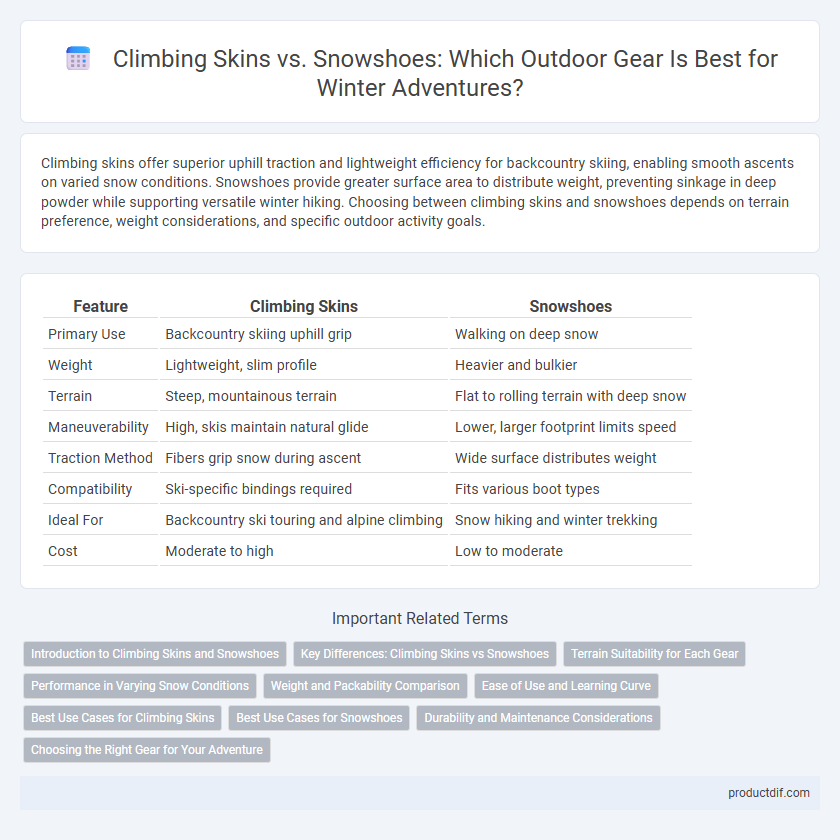Climbing skins offer superior uphill traction and lightweight efficiency for backcountry skiing, enabling smooth ascents on varied snow conditions. Snowshoes provide greater surface area to distribute weight, preventing sinkage in deep powder while supporting versatile winter hiking. Choosing between climbing skins and snowshoes depends on terrain preference, weight considerations, and specific outdoor activity goals.
Table of Comparison
| Feature | Climbing Skins | Snowshoes |
|---|---|---|
| Primary Use | Backcountry skiing uphill grip | Walking on deep snow |
| Weight | Lightweight, slim profile | Heavier and bulkier |
| Terrain | Steep, mountainous terrain | Flat to rolling terrain with deep snow |
| Maneuverability | High, skis maintain natural glide | Lower, larger footprint limits speed |
| Traction Method | Fibers grip snow during ascent | Wide surface distributes weight |
| Compatibility | Ski-specific bindings required | Fits various boot types |
| Ideal For | Backcountry ski touring and alpine climbing | Snow hiking and winter trekking |
| Cost | Moderate to high | Low to moderate |
Introduction to Climbing Skins and Snowshoes
Climbing skins are adhesive strips attached to the bottom of skis, providing traction on snow-covered slopes to enable uphill travel in backcountry skiing. Snowshoes distribute a hiker's weight over a larger surface area, preventing sinking into deep snow and allowing for easier walking in snowy terrain. Both climbing skins and snowshoes enhance mobility in winter environments but are designed for different activities and snow conditions.
Key Differences: Climbing Skins vs Snowshoes
Climbing skins offer superior traction on steep and icy terrain by attaching directly to skis, enabling efficient uphill travel without sinking into deep snow. Snowshoes distribute weight over a larger surface area, preventing sinking in soft, powdery snow and making them ideal for flat or rolling terrain. The choice between climbing skins and snowshoes hinges on terrain type, snow conditions, and intended activity, with skins favoring ski touring and snowshoes excelling in general snow hiking.
Terrain Suitability for Each Gear
Climbing skins excel on steep, icy slopes and backcountry ascents by providing grip and efficient uphill movement on narrow skis. Snowshoes are ideal for traversing deep, soft snow and uneven terrain in forests or flat to rolling landscapes, distributing weight to prevent sinking. Choosing the right gear depends on terrain: climbing skins for alpine climbs and technical routes, snowshoes for snow-covered trails and gentle to moderate inclines.
Performance in Varying Snow Conditions
Climbing skins provide superior traction and efficiency on steep, icy, or variable snow conditions, allowing for smooth uphill movement with minimal energy loss. Snowshoes excel in deep, soft, or powdery snow by distributing weight over a larger surface area, preventing sinking and enhancing floatation. Choosing between climbing skins and snowshoes depends on terrain steepness and snow consistency to optimize mobility and control.
Weight and Packability Comparison
Climbing skins are significantly lighter and more compact than snowshoes, making them ideal for backcountry skiers prioritizing weight savings and packability. Snowshoes tend to be bulkier and heavier due to their larger frame and bindings, which can add extra weight and volume to your pack. Choosing climbing skins enhances mobility and reduces fatigue on ascents, while snowshoes provide stable flotation but require more storage space.
Ease of Use and Learning Curve
Climbing skins offer greater efficiency and speed on steep, variable terrain but require a moderate learning curve to master proper attachment and technique. Snowshoes provide straightforward use with minimal setup and a gentler learning curve, making them ideal for beginners navigating flat or rolling snowy landscapes. Both have distinct ease-of-use advantages depending on terrain complexity and user experience.
Best Use Cases for Climbing Skins
Climbing skins excel in backcountry skiing and ski touring, providing superior uphill traction on steep, icy, or variable snow surfaces where precise grip is essential. They allow skiers to efficiently ascend mountainous terrain without slipping, making them ideal for alpine environments and long-distance winter expeditions. Unlike snowshoes, climbing skins are designed to work seamlessly with skis, enhancing mobility and speed in snow-covered backcountry conditions.
Best Use Cases for Snowshoes
Snowshoes are ideal for traversing deep, powdery snow and uneven terrain where distributing weight prevents sinking, making them perfect for winter hiking and snow trekking. Their wide surface area offers enhanced stability and balance on soft snow, which is particularly useful for exploring trails in backcountry or forested areas. Snowshoes excel in providing traction on icy or packed snow conditions, ensuring safer and more efficient movement during winter outdoor adventures.
Durability and Maintenance Considerations
Climbing skins, made from high-strength synthetic fibers such as nylon or mohair, offer exceptional durability but require regular cleaning and proper drying after use to prevent glue degradation and fiber damage. Snowshoes often utilize aluminum frames with synthetic decking materials that resist wear well and demand minimal maintenance, primarily requiring checks for frame bends and strap integrity. Proper care extends the lifespan of both climbing skins and snowshoes, with climbing skins needing more frequent attention to preserve adhesive function and performance in varied snow conditions.
Choosing the Right Gear for Your Adventure
Climbing skins offer superior traction and efficiency for backcountry skiing by allowing uphill travel without slipping, ideal for steep, snowy terrain. Snowshoes provide stability and flotation on deep, powdery snow, making them perfect for hiking or exploring flatter, less technical trails. Selecting the right gear depends on your planned route, snow conditions, and activity intensity to ensure safety and maximize performance.
Climbing skins vs Snowshoes Infographic

 productdif.com
productdif.com